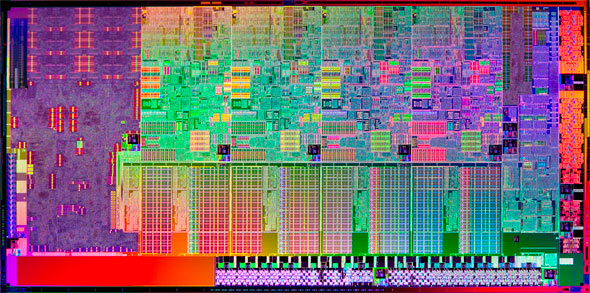Intel Core i7-2600K and i5-2500K Processors Debut
Today’s pre-launch of Intel’s Sandy Bridge-based processors should come as no surprise to anyone who even remotely follows the PC tech scene. We, along with Intel and numerous other companies and media outlets, have been slowly leaking Sandy Bridge and Sandy Bridge-related details for many months now. Heck, we’ve even showed off a number of Sandy Bridge compatible motherboards in the past, posted pics of actual processors, and discussed many of the microarchitecture’s features already. We obviously weren’t able to disclose all of the platform’s specifics, however, and boy is there a lot still to cover. That’s what this article is for.
We’ve had a few Core i5 and Core i7 Sandy Bridge based processors kicking around the HotHardware labs for a while now, along with a sampling of 6-series chipset based motherboards to go along with them. We’ve been poking, prodding, and testing them to get a good feel for what Sandy Bridge and 6-Series chipset is all about and we’ve amassed a boatload of data to share with you all here. In addition to putting a couple of Core i5 and Core i7 Sandy Bridge based processors to the test in our usual suite of benchmarks, we’ve also tested their new integrated graphics core and media encoding engine, tested various multi-GPU setups, overclocked Sandy Bridge, and even evaluated a few mainstream and enthusiast-class motherboards.
Our aim was to provide a sort of “one stop shop” for all things Sandy Bridge. Whether we’ve succeeded or not doesn’t really matter, because there’s a ton of info and data to work through regardless! And when you're done here, we've also got the down low on Sandy Bridge mobile offerings as well. So step right up, get your mice warmed up, and strap in as we (finally) give you the full scoop on Sandy Bridge and all of the goodness that’s coming along with it...


Intel Socket 1155 Sandy-Bridge Based Core i5 Processor, Click To Enlarge
|
Intel Core i7-2600K Processor Key Features:
-
8-Way Multi-Task Processing: Runs 8 independent processing threads in one physical package.
-
Intel Turbo Boost Technology 2.0: Dynamically increases the processor frequency up to 3.80GHz when applications demand more performance. Speed when you need it, energy efficiency when you don’t.
-
Intel Hyper-Threading Technology: Allows each core of the processor to work on two tasks at the same time providing unprecedented processing capability for better multi-tasking, and for threaded applications.
-
Intel Smart Cache: 8MB of shared cached allows faster access to your data by enabling dynamic and efficient allocation of the cache to match the needs of each core significantly reducing latency to frequently used data and improving performance.
-
Intel HD Graphics 3000: Significant 3D performance for immersive mainstream gaming on a broad range of titles. The dynamic graphics frequency ranges up to 1350MHz.
Intel Core i5-2500K Processor Key Features:
-
4-Way Multi-Task Processing: Runs 4 independent processor threads in one physical package.
-
Intel Turbo Boost Technology 2.0: Dynamically increases the processor frequency up to 3.7 GHz when applications demand more performance. Speed when you need it, energy efficiency when you don’t.
-
Intel Smart Cache: 6MB of shared cached allows faster access to your data by enabling dynamic and efficient allocation of the cache to match the needs of each core significantly reducing latency to frequently used data and improving performance.
-
Intel HD Graphics 3000: Significant 3D performance for immersive mainstream gaming on a broad range of titles. The dynamic graphics frequency ranges up to 1100MHz.
Shared Features:
-
CPU Overclocking Enabled (with Intel P67 Express Chipset): Fully unlocked core multiplier, power, and DDR3 memory ratios enable ultimate flexibility for overclocking.
-
Graphics Overclocking Enabled (with Intel H67 Express Chipset): Unlocked graphics multiplier allows for overclocking to boost the graphics clock speed.
-
Integrated Memory Controller: Supports 2 channels of DDR3-1333 memory with 2 DIMMs per channel. Support for memory based on the Intel Extreme Memory Profile (Intel XMP) specification.
-
Chipset/Motherboard Compatibility: Compatible with all Intel 6 Series Chipsets.
-
AES-NI: Provides 6 processor instructions that help to improve performance for AES encryption and decryption algorithms.
-
Built-in Visuals3: New enhanced built-in visual features deliver a seamless visual PC experience for doing everything from simple e-mail to enjoying the latest 3D and HD entertainment. The built-in visuals suite includes:
-
Intel Quick Sync Video Technology: Media processing for incredibly fast conversion of video files for portable media players or online sharing.
-
IntelInTru3D: Stereoscopic 3D Blu-ray* playback experience in full HD 1080p resolution over HDMI 1.4 with 3D.
-
Intel Clear Video HD Technology: Visual quality and color fidelity enhancements for spectacular HD playback and immersive web browsing.
-
Intel Advanced Vector Extensions (Intel AVX): Increased performance for demanding visual applications like professional video & image editing.

Intel Sandy Bridge Processor Die
For those of you not quite familiar with Intel’s codenames, Sandy Bridge is the codename of a brand new microarchitecture that will be foundation of an entire line of desktop and mobile processors in 2011 and beyond. It is a “Tock” in Intel’s CPU release cadence, which means it is almost completely new and not a mild revision of an existing microarchitecture.

Above we have a die shot of a Sandy Bridge processor, along with the features and specifications of the new Core i5-2500K and Core i7-2600K processors we’ll be showcasing here. Some of the features will sound similar to previous Intel processor offerings, but make no mistake, these are completely new chips. They may borrow some aspects from previous Intel CPU microarchitectures, but with Sandy Bridge, Intel has redesigned virtually all of the execution engines, integrated a relatively powerful graphics core, and implemented a new ring bus to allow core elements to communicate, among many other features and enhancements.







